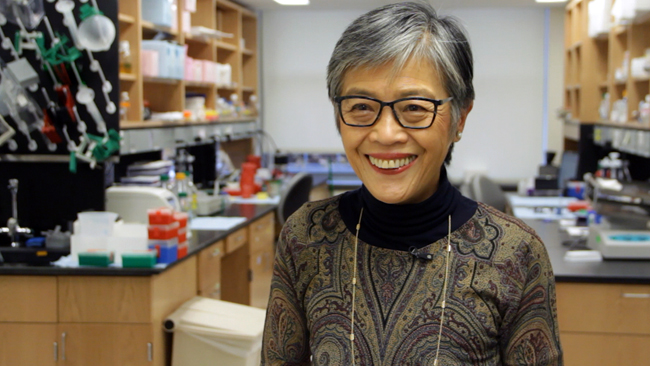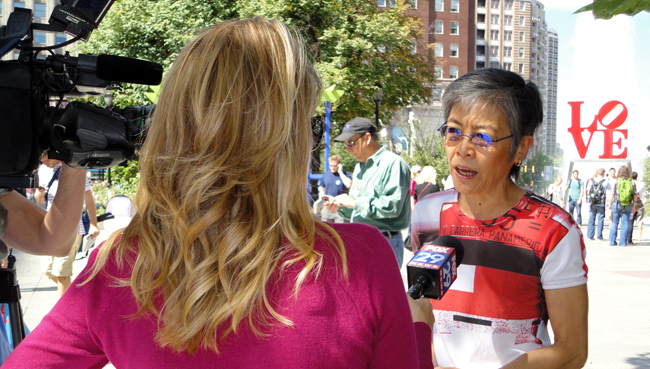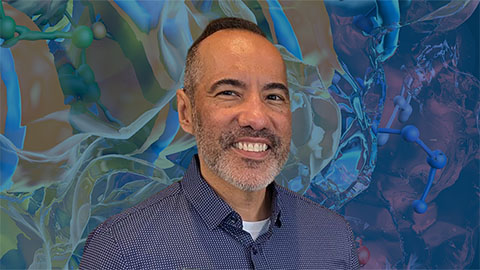Virginia Lee: notes on a career
“I never really had a role model,” says Virginia M-Y Lee, director at the Center for Neurodegenerative Disease Research at the University of Pennsylvania, pausing to reflect on her unusual career path. “I made decisions based on a number of factors — of where I wanted to go and live, what I wanted to see and what I wanted to learn. Then I just went and did it.”
This attitude of getting things done without following preset directions could be credited for Lee’s scientific success. Over the course of three decades, Lee and her husband, John Trojanowski, co-director of the center, have spearheaded efforts to identify some of the proteins involved in Alzheimer’s, Parkinson’s, frontotemporal dementia and amyotrophic lateral sclerosis, known as ALS or Lou Gehrig’s disease. “Science is so exciting now. I would have never imagined, as a high-school girl or even as a postdoc, where I am right now,” says Lee. “It’s a very interesting journey for me.”
 Indeed, it is an interesting journey, especially when one realizes Lee didn’t have a conventional entry into a scientific career. For there was a time in her life when Lee was training to be a concert pianist.
Indeed, it is an interesting journey, especially when one realizes Lee didn’t have a conventional entry into a scientific career. For there was a time in her life when Lee was training to be a concert pianist.
“Couldn’t wait to get out”
Lee was born in Chongqing in southwest China in the 1950s and moved to Hong Kong when she was 5 years old. “We lived as an extended family — lots of aunts, uncles, cousins and brothers,” recalls Lee. In the chaos of a large family, Lee says, no one paid much attention to her. Her father, a restaurateur with businesses in Hong Kong and on the U.S. West Coast, was rarely around. When Lee was about 11, most of her relatives, including her mother, left Hong Kong for the U.S. “I stayed behind with one of my brothers and my paternal grandmother to finish high school,” says Lee.
She attended a Chinese primary school, where the classes were taught in Chinese, and spent a year in a Chinese high school before she moved to a high school where the language of instruction was English. “It was a difficult switch,” says Lee. “But I was competitive. I looked around at my classmates and thought, ‘I’m not as good in English as they are. But science is a new language for everyone.’ We were all on an even playing field.”
Besides science, Lee excelled at something else. Her mother insisted that she learn the piano, for which Lee demonstrated aptitude. When the time came for her to take the next step after high school, her mother told her to apply to the prestigious Royal Academy of Music in the U.K. Lee did as she was told, but she also had an ulterior motive. “Hong Kong is a very small town. I couldn’t wait to get out,” she says. “I just was thrilled to have the opportunity to get out of Hong Kong and go someplace else and explore.”
Lee arrived in London in 1962, eager to learn about the British people and their norms and customs. “When you go to a foreign country, one thing for me, always, is you want to learn more about the people,” she says. “There is no point being in a foreign country if you stick to your own community.”
As she adjusted to her new life, however, she acknowledged she had a problem. Lee found the eight hours of daily piano practice to be maddening and felt she lacked sufficient talent to make it big. “I realized it’s difficult to make a career out of piano, unless you are really outstanding,” she says. “I think if I had been playing the violin, my career might have been different, because it’s easier to be a member of an orchestra than a soloist. Piano doesn’t give you much choice in that matter.”
So Lee persuaded her mother to allow her to attend college to study science. Her mother’s stipulation was that Lee had to keep up with her music training while attending the University of London’s undergraduate chemistry program. But after plugging away at the Royal Academy of Music for two years, “I quit,” says Lee. “My heart wasn’t in it.” From then on, Lee threw herself into science.
Because she had found chemistry “a bit too dry,” Lee decided to steer toward biochemistry for her master’s degree in the late 1960s. “I wanted to learn something that is more relevant to life,” she says. She did her master’s under Nobel laureate Ernst Chain’s supervision at Imperial College. The first day at the engineering and technology institution still stands out in Lee’s mind: “That first day was a real shocking experience. I was in this hall with 3,000 people. I looked around and thought, ‘Holy moly, there is not a single woman in this room.’”
Coming to America
As she got closer to finishing her master’s degree, Lee considered her next move. She hadn’t lived with or even been near her parents since she was 11, and she decided it was time to get to know her mother better. “My mother was living in L.A., and I thought, ‘San Francisco is close enough, so I can visit her a lot but I can still live on my own,’” says Lee. “That’s why I made that choice to go to UCSF. It turned out to be a good solution. I did get to see her a lot, but I still could do my own thing and go to graduate school.”
At the University of California, San Francisco, Lee worked with C.H. Li, “who was one of the great biochemists in purifying pituitary hormones,” she says. Li’s achievements included isolating luteinizing hormone, synthesizing human growth hormone and identifying beta-endorphin and insulinlike growth factor 1. Lee learned about endocrinology, biochemistry, pharmacology and biophysics.
Still stricken with wanderlust, Lee in 1973 moved to the Netherlands after she completed her Ph.D. for a yearlong postdoctoral stint at the University of Utrecht. It was at this juncture that Lee became curious about the brain, as her work on pituitary glands turned her attention toward it. “I thought the brain was a fascinating organ, because it regulates so many things,” she says. “Also, not much is known about it, so I was just fascinated.”
But the scientific fit at Utrecht wasn’t a good one, so Lee decided she needed to get back to the U.S. It just so happened that a friend from graduate school was doing a postdoctoral fellowship at the Pasteur Institute in Paris. Lee regularly hopped on the train and visited her friend on weekends. At the Pasteur Institute, she met Michael Shelanski, who was wrapping up a sabbatical and preparing to set up a research group with Lloyd Greene at the Children’s Hospital at Harvard University. Shelanski, an expert in Alzheimer’s disease who is now at Columbia University, asked Lee if she’d be interested in joining his group in Boston as a postdoctoral fellow. “I said, ‘OK,’ and off I went,” says Lee.
Boston
In 1974, Lee once again was in a new place to do research and explore. But this time, life had more excitement than usual in store in the form of John Trojanowski. He was then an M.D./Ph.D. student training in pathology, and he’s been Lee’s life and scientific partner for more than 30 years now. Lee had noticed Trojanowski at a seminar in 1974 at Harvard and around town on other occasions (“with another girlfriend,” notes Trojanowski). But it was only on April 30, 1976, at the bar in the Copley Plaza Hotel (now the Fairmont Copley Plaza), that Lee finally got a chance to strike up a conversation with him. They realized they had lived in the Netherlands at the same time, he in Rotterdam and she in Utrecht, and that they had attended the same concert at London’s St. Martin in the Fields, an Anglican church that hosts one of the U.K.’s longest running free musical series.
Trojanowski says his first impression of Lee was that she was a “ravishingly beautiful woman who was extremely bright and very engaging, a woman of her own views and opinions.” Soon, they were a couple, and they married in 1979. “We love to be with each other,” says Trojanowski. “We also fight like hell.”
Their arguments, especially about science, are legendary, to the point that Shankar Vedantam devoted a part of a chapter in his 2010 book “The Hidden Brain” to their disagreements. Lee and Trojanowski both hasten to add that they’ve lately toned down their public sparring.
“I think we’ve scared a number of people,” says Trojanowski with a chuckle. He tells a story of when Lee’s niece Suzette spent a summer with them to do a high-school research project in the 1980s. “We went to see ‘Evita’ in New York, and we were going to buy tickets. Somehow, we got into a huge fight in Times Square and jumped out of the car, screaming and yelling at each other,” recounts Trojanowski. “Her niece went home and said, ‘They are going to get divorced! You can’t believe how much they fight!’”
Philadelphia
Shortly after the couple married, a job in the biotechnology sector beckoned Lee to Philadelphia. Smith, Kline & French, now GlaxoSmithKline, offered her a position to build up its neuroscience research portfolio. Trojanowski was in the middle of his neuropathology training at the Massachusetts General Hospital. “We had our first big fight then, because I wanted to stay at Mass General,” says Trojanowski. He also had doubts about Philadelphia. “The mayor at the time was a guy named Frank Rizzo, who, when asked about his politics, said he was to the right of Genghis Khan,” says Trojanowski. “Boston, at the time, was on the economic rise. Philadelphia was in the doldrums.”
But in a signature move of their life together, “we discussed, compromised and came up with the best decision for the way forward for the both of us,” says Trojanowski. The couple moved in 1980 to Philadelphia so that Lee could take up the job offer, and Trojanowski transferred to the University of Pennsylvania medical school and later accepted a tenure-track position there.
Yet Lee’s new pharmaceutical job turned out to be a disappointment. She found she wasn’t being allowed to study neuroscience. “I was in a very compromised position. I was in misery,” she says of the year she stuck it out in that job. The university came to her rescue. There wasn’t a tenure-track position available, but Trojanowski’s boss was able to offer Lee a research-track position, which she accepted.
But she was immediately beset by doubt. Although she had bagged an RO1 grant from the National Institutes of Health, Lee wondered if she needed a backup plan. “At that time, Ronald Reagan was going to privatize the NIH,” says Lee. “If there was no NIH, there would be no funding for research. My husband can deliver babies. What would I do?”
So Lee applied to the Wharton School of Business at Penn to get an M.B.A. Her thinking was that the M.B.A. would let her step up the corporate ladder in the pharmaceutical industry. “But then the science really took off,” says Lee. “I never looked back.”
The M.B.A. training comes in handy in running a research team of up to 50 people. Lee and Trojanowski work with clinicians and help them store their data and bank samples, run a drug-discovery program, and pursue basic science research. Organizing and managing all that requires implementing an infrastructure, which Lee says her business education taught her to do. But more importantly, Lee says, the M.B.A. has helped her think like a small-business owner. “Running your own lab is like running a mom-and-pop shop,” she says. “You get money. You have to pay bills. You have to order supplies and so on. On the small scale, it’s not as important, but when it’s on the large scale, any kind of business training and organization skills, as well as knowing about finances, is important to running a big lab.”

Scaling great walls
When they both started at Penn, Lee had a project on the effects of nerve growth factor on PC12 cells, and Trojanowski was studying axonal transport and endocytosis. In 1983, the two collaborated on a project for which Trojanowski did electron microscopy on the filamentous inclusions that formed when NGF interacted with PC12 cells, and Lee did the biochemistry of the receptor-NGF interaction. They had so much fun working together that they considered building a joint research program. Neurodegenerative diseases beckoned.
“We knew nothing about the identity of neurofibrillary tangles or senile plaques or any of these disease proteins in neurodegenerative diseases,” says Lee. They recognized that Alzheimer’s disease was going to become an increasingly important illness in society (see the April 2013 ASBMB Today cover story). Lee and Trojanowski knew they could tackle the complex disorder from different angles. Trojanowski, as a neuropathologist, had access to brains from patients who consented to autopsy. Because he was responsible for making the final diagnosis of what killed a patient, he would know which brain samples were from patients with Alzheimer’s disease.
Then there was Lee, the biochemist who came to realize she had something special to bring to Alzheimer’s research. “In the 1980s, I was asked to serve on study sections because there weren’t that many women at that time. ‘Asian’ was also still considered to be a minority,” she says. “I was three to four years into my faculty position and I was already on study sections.” There, she realized that the people studying neurodegenerative disorders were M.D.s. “They are not well-trained in basic science,” says Lee.
So she and Trojanowski decided to make it their goal to isolate systematically and identify the disease proteins in neurodegenerative disorders, starting with Alzheimer’s disease. Before they launched their project, they asked senior faculty for their opinions. “All of them, except for one person, said, ‘This is a crazy, stupid idea. Alzheimer’s is a wasteland. You’ll ruin your careers,’” recalls Trojanowski. “The only one who was supportive was Vince Cristifalo, who started the Institute on Aging.” (Trojanowski is now the director of the institute.)
Even family members had doubts, Trojanowski recalls: “Virginia’s father is a no-nonsense businessman. He said, ‘Look, John and Virginia, you’re not going to solve this in your lifetime.’ I said, ‘Jack, when the Great Wall of China was built, people who were putting the very first bricks in the ground knew they wouldn’t live to see the end of the wall being built as a defense structure. You just have to believe what you’re doing is important and will be impactful over time.’ He said, ‘OK, I get it.’”
In 1991, in a Science paper, a team led by Lee and Trojanowski demonstrated that the cytoskeletal protein tau is a building block of neurofibrillary tangles, one of the characteristics of Alzheimer’s disease. Over the years, they and colleagues have identified α-synuclein as a protein in Lewy bodies, a hallmark of Parkinson’s disease, and TDP-43, the protein involved in ALS.
In the past decade, hints of a theme have emerged from their work and that of others, says Lee. In the fall of 2012, their group demonstrated that misfolded versions of α-synuclein, the protein implicated in Parkinson’s disease, can be transmitted from cell to cell in mouse models, adding weight to a hypothesis that a common mechanism of neurodegenerative disorders could involve the passage of misfolded proteins through the central nervous system. In the 1980s, “it was only a dream that there would be a common mechanism,” says Lee. “I think in the next 10 years or so, the field as a whole will prove there is a common mechanism for the progression” of neurodegenerative disorders.
Trojanowski admits they’ve grown increasingly workaholic with age. “We are science addicts,” he says. Lee still plays the piano over the Christmas and New Year’s break, but once the holidays are over she is ready to throw herself back into science. “There’s a time and a place to do certain things,” Lee says. “As long as I can work and keep up with the pace, I would like to contribute. If there is some disease-modifying therapy for Alzheimer’s and Parkinson’s in my lifetime, I would be delighted. If I contribute to it, that would be even better.”
Enjoy reading ASBMB Today?
Become a member to receive the print edition four times a year and the digital edition monthly.
Learn moreGet the latest from ASBMB Today
Enter your email address, and we’ll send you a weekly email with recent articles, interviews and more.
Latest in People
People highlights or most popular articles

Mapping proteins, one side chain at a time
Roland Dunbrack Jr. will receive the ASBMB DeLano Award for Computational Biosciences at the ASBMB Annual Meeting, March 7–10, just outside of Washington, D.C.

2026 voter guide
Learn about the candidates running for Treasurer-elect, Councilor and Nominating Committee.

Meet the editor-in-chief of ASBMB’s new journal, IBMB
Benjamin Garcia will head ASBMB’s new journal, Insights in Biochemistry and Molecular Biology, which will launch in early 2026.

Exploring the link between lipids and longevity
Meng Wang will present her work on metabolism and aging at the ASBMB Annual Meeting, March 7-10, just outside of Washington, D.C.

Defining a ‘crucial gatekeeper’ of lipid metabolism
George Carman receives the Herbert Tabor Research Award at the ASBMB Annual Meeting, March 7–10, just outside of Washington, D.C.

Nuñez receives Vallee Scholar Award
He will receive $400,000 to support his research.

